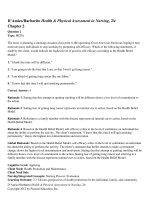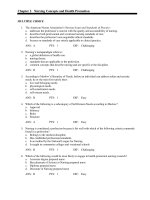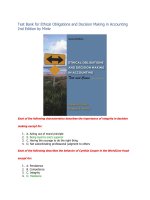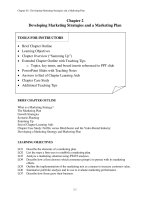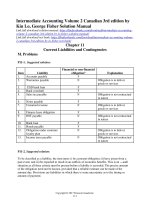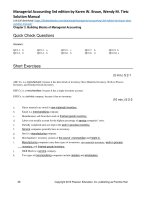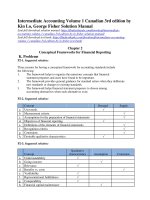Health and physical assessment in nursing 3rd edition by DAmico barbarito solution manual
Bạn đang xem bản rút gọn của tài liệu. Xem và tải ngay bản đầy đủ của tài liệu tại đây (379.95 KB, 8 trang )
Health and Physical Assessment in Nursing 3rd edition by Donita T D'Amico, Colleen
Barbarito Solution Manual
Link full download solution manual: />Link full download test bank: />
D’Amico Chapter 2
Concepts for Lecture
Resource Library
PEARSON NURSING STUDENT RESOURCES
Key Concepts
Application Through Critical Thinking Case Study
Documentation
NCLEX-RN® Review
Media Link Application
Media Links
Audio Glossary
Toolbox
NY Times
LEARNING OUTCOME 1
Describe the concepts of wellness and health promotion.
Concepts for Lecture
1. Wellness describes a state of life that is balanced, personally satisfying, and characterized by
health-enhancing behaviors.
2. Health promotion refers to those actions used to increase health or well-being of individuals,
families, and communities.
3. Individual health promotion includes identification of biologic, lifestyle, and environmental
risks that influence wellness and promoting efforts to reduce risks.
©2012 by Pearson Education, Inc.
D’Amico/Barbarito, Instructor’s Resource Manual for Health & Physical Assessment In Nursing,
2nd Edition
PowerPoint Slides
1. Wellness—A State of Life That Is Balanced, Personally Satisfying, and Characterized by
Health-Enhancing Behaviors
2. Health Promotion—Actions to Increase Health and Well-Being of Individuals, Families, and
Communities
3. Individual Health Promotion—Biological, Lifestyle, and Environmental Risks
Suggestions for Classroom Activities
Ask students to write and discuss their own definitions of wellness and health promotion.
Suggestions for Clinical Activities
Have students ask another health professional to define wellness and health promotion.
LEARNING OUTCOME 2
Discuss the theories of wellness.
Concepts for Lecture
1. Dunn defined wellness as an integrated method of functioning, oriented toward maximizing
the potential of the individual. Dunn’s theory of wellness uses two intersecting axes: health
and environment.
2. Leavell and Clark describe wellness in terms of primary, secondary, and tertiary levels of
prevention. Primary prevention implies health and a high level of wellness for the individual.
Secondary prevention involves early diagnosis of health problems and prompt treatment with
restoration of health. Tertiary prevention is activity aimed to restore the individual to the
highest possible level of health and functioning.
3. Travis and Ryan use a continuum to describe the state of health with high-level wellness and
premature death at the ends of the continuum.
PowerPoint Slides
1. Dunn (Figure 2.1)
Definition
Health and environment
©2012 by Pearson Education, Inc.
D’Amico/Barbarito, Instructor’s Resource Manual for Health & Physical Assessment In Nursing,
2nd Edition
2. Levels of Prevention (Figure 2.2 and Table 2.1)
Primary
Secondary
Tertiary
3. Travis—Continuum
High-level wellness
Premature death
Suggestions for Classroom Activities
Ask students to compare and contrast the theories of wellness.
LEARNING OUTCOME 3
Discuss the perspectives of health promotion for the individual, family, and community.
Concepts for Lecture
1. A variety of models have been developed to explain health promotion behaviors, which
include the health belief model, the theory of reasoned action/planned behavior, and the
health promotion model. Health promotion models guide interventions.
2. The health belief model predicts which individuals will participate in health screenings or
obtain vaccinations. It includes two constructs, which are cues to action and self-efficacy.
3. According to the theory of reasoned action/planned behavior, the intention to perform a
behavior is a determinant in performance of the behavior. This intention is affected by
subjective norms, attitudes, and self-efficacy.
4. The health promotion model focuses on variables that impact motivation and behavioral
outcomes. The aspects of the model include individual characteristics and behaviors,
behavior-specific cognition and affect, perceived benefits of action, perceived barriers to
action, activity-related affect, situational influences, commitment to a plan of action, and
behavioral outcomes.
5. Personal factors that can influence behavior are biologic, psychologic, and sociologic.
6. Nursing interventions should focus on modifiable health risk factors as well as health
assessment and screening.
©2012 by Pearson Education, Inc.
D’Amico/Barbarito, Instructor’s Resource Manual for Health & Physical Assessment In Nursing,
2nd Edition
7. Environments that are safe, interesting, and promote comfort and acceptance versus
alienation are factors that facilitate health promotion.
PowerPoint Slides
1. Models for Health Promotion—Health Belief Model, Theory of Reasoned Action/Planned
Behavior, Health Promotion Model
2. Health Belief Model (Figures 2.4 and 2.7)
Cues to self-action
Self-efficacy
3. Theory of Reasoned Action/Planned Behavior (Figures 2.5 and 2.8)
Subjective norms
Attitudes
Self-efficacy
4. Health Promotion Model (Figures 2.6 and 2.9)
Individual characteristics and behaviors
Behavior-specific cognition and affect
Perceived benefits of action
Perceived barriers to action
Activity-related affect
Situational influences
Commitment to a plan of action
Behavioral outcomes
5. Personal Factors
Biologic
Psychologic
Sociologic
6. Nursing Interventions
7. Environmental Factors
©2012 by Pearson Education, Inc.
D’Amico/Barbarito, Instructor’s Resource Manual for Health & Physical Assessment In Nursing,
2nd Edition
Suggestions for Classroom Activities
©2012 by Pearson Education, Inc.
D’Amico/Barbarito, Instructor’s Resource Manual for Health & Physical Assessment In Nursing,
2nd Edition
Ask students to compare and contrast health promotion models.
LEARNING OUTCOME 4
Describe the goals, topic areas, and objectives in Healthy People 2020.
Concepts for Lecture
1. Topic areas and recommendations for Healthy People 2020 include physical activity,
nutrition, tobacco use, alcohol and substance abuse, sexual and reproductive health, mental
health, injury and violence prevention, occupational health and safety, environmental health,
oral health, emerging issues, and preventive services.
2. The document provides an overview of the goals and recommendations and how it advocates
for the improvement of health and addresses environmental factors that contribute to health
and illness. The goals will redirect attention from health care to health determinant topic
areas.
PowerPoint Slides
1. Healthy People 2020 Topics and Recommendations
Physical activity (Table 2.3 and Figure 2.10)
Nutrition
Tobacco use
Alcohol and substance abuse
Sexual and reproductive health
Mental health (Figure 2.11)
Injury and violence prevention (Tables 2.4)
Occupational health and safety
Environmental health
Oral health
Emerging issues
Preventive services (Table 2.6)
2. Topic Areas and Recommendations (Table 2.2)
Suggestions for Classroom Activities
Ask students to identify examples of health promotion behaviors that should be
emphasized with each of the Healthy People 2020 topic areas.
Suggestions for Clinical Activities
©2012 by Pearson Education, Inc.
D’Amico/Barbarito, Instructor’s Resource Manual for Health & Physical Assessment In Nursing,
2nd Edition
Have students identify clients with illnesses that could have been prevented with
improved health promotion behaviors.
LEARNING OUTCOME 5
Discuss health promotion in relation to the nursing process.
Concepts for Lecture
1. Comprehensive health assessment is essential to health promotion.
2. The professional nurse takes on a variety of roles when implementing plans for health
promotion. These roles include educator, counselor, facilitator, nurturer, and role model.
3. As educator the nurse interprets and informs the client of findings from the assessment.
4. As counselor the nurse creates and plans opportunities to discuss the implementation of
specific activities or goal attainment.
5. The nurse as a facilitator helps the client and family gain access to services and facilities.
6. The nurturing role of the nurse includes providing support and encouragement.
7. The nurse models wellness and health promoting behaviors.
8. Evaluation of goals for health promotion is an ongoing process that may result in new
priorities or strategies to meet health-related goals.
PowerPoint Slides
1. Assessment and Health Promotion (Box 2.1)
2. Roles of the Nurse in Implementing Health Promotion
Educator
Counselor
Facilitator
Nurturer
Role model
3. Educator
©2012 by Pearson Education, Inc.
D’Amico/Barbarito, Instructor’s Resource Manual for Health & Physical Assessment In Nursing,
2nd Edition
4. Counselor
5. Facilitator
6. Nurturer
7. Role Model
8. Evaluation of Goals for Health Promotion
Suggestions for Classroom Activities
Divide students into groups and ask them to outline a nursing care plan for the following
groups of clients focusing on their health promotion needs: pregnant teenagers receiving
prenatal care, young males playing organized sports, new breast-feeding mothers and
their newborns, and elderly retirees living in an assisted care facility.
Suggestions for Clinical Activities
Assign students to care for clients experiencing illnesses that could have been prevented
with improved health promotion behaviors.
©2012 by Pearson Education, Inc.
D’Amico/Barbarito, Instructor’s Resource Manual for Health & Physical Assessment In Nursing,
2nd Edition
